
GINZA CONNECTIVE
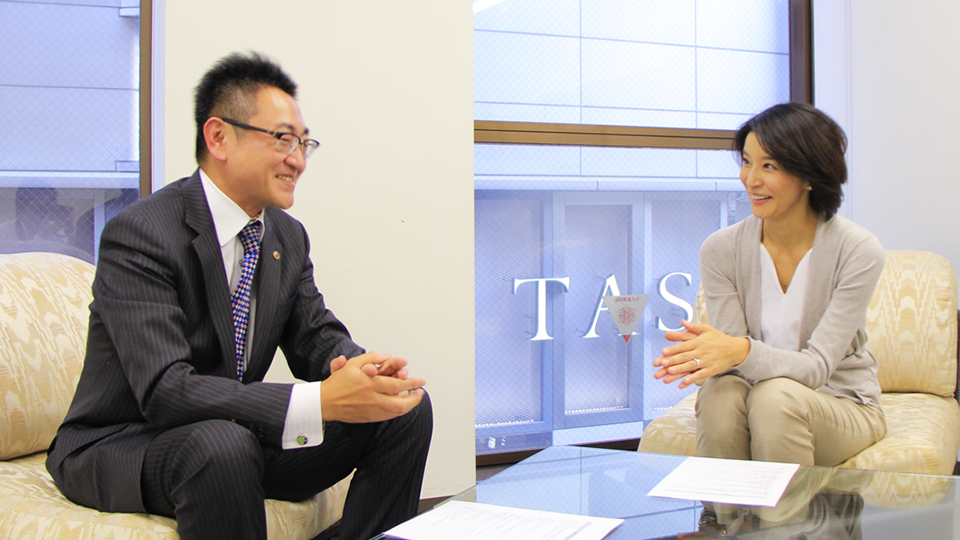
GINZA CONNECTIVE VOL.30
Shigeyuki Ando×Chisako Takashima
2014.03.05
A talk series with the violinist Chisako Takashima and the Ginza people. Ginza holds many personal and professional memories for Takashima. In this talk series, she thoroughly explores various aspects of the Ginza culture with her guests. Today’s guest is Shigeyuki Ando, the president of the Tokyo Ando Cloisonne shop known for such gorgeous techniques that it even receives orders from the Imperial Household Agency.
Ginza is a branch shop — the main shop is in Nagoya.
- Takashima
- Thank you for talking with me today. Let me start by saying that my sister used to make cloisonne ware. When I called my mother this morning and told her I was going to see you today, she said, “That place is truly amazing.”
- Ando
- She is too kind. What kind of cloisonne pieces did your sister make?
- Takashima
- As a hobby, she made things like ornaments for kimonos and bag hooks.
- Ando
- Is that so? Cloisonne can be enjoyed in many ways, from hobby to artisan level. We also sell bag hangers. People may think cloisonne is very expensive, but the pieces we sell range widely from those you can buy easily at only a few thousand yen to more expensive items.
- Takashima
- Please tell me all about it. You’re the president of the Tokyo shop. Tokyo is a branch shop?
- Ando
- Yes. Many people think the shop in Ginza is the main shop, but the main shop is actually the one in Nagoya.
- Takashima
- I love Nagoya! The food is delicious, so when a musician gets asked to play there, they immediately say yes (laughs). Are you from Nagoya?
- Ando
- Yes. I was born and raised in Nagoya. My father is still actively running the main shop as its president, so I left him in charge there and moved here in my early 30s.
- Takashima
- That’s amazing that the Ginza shop is just a branch.
- Ando
- Most Ginza shops are main branches, so it is certainly rare. Aichi Prefecture is famous for its crafts, with earthenware and Tokoname ceramics in addition to cloisonne ware.
- Takashima
- The business was founded over 130 years ago. How old is the Tokyo shop?
- Ando
- The Ginza shop opened in 1890. Before opening the cloisonne shop there, it was a tobacco pipe shop. The decorative part of the pipe is made of metal fittings and silverwork, so the cloisonne business was started to make those parts. My great-grandfather’s brother-in-law turned it into a specialty cloisonne ware shop in 1880. Ten years later, in 1890, he went to Ginza in search of a larger market.
- Takashima
- Was it located here from the start?
- Ando
- No, it actually started in a rental house in front of where Matsuya is currently located. But Nagoya people have a strong desire to do business in a shop they own personally, so the current place was purchased and the shop was moved here.
- Takashima
- This building is very big. Is it completely devoted to cloisonne ware?
- Ando
- The shop is only on the first and second floors, and the third floor is our office. The rest is rented out to tenants.
- Takashima
- Sounds like a pretty good deal (laughs).
- Ando
- I have to be very grateful to my past relatives.
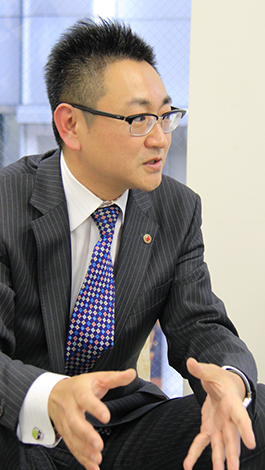
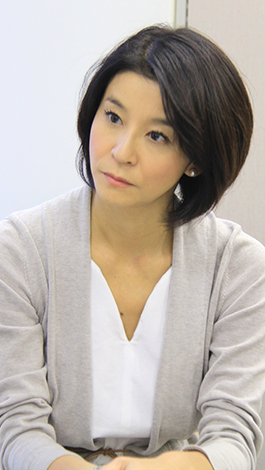
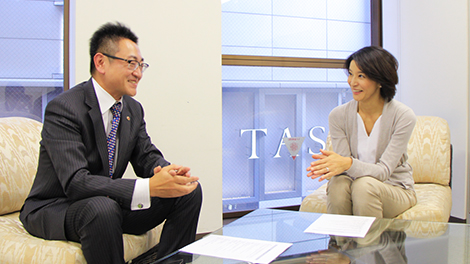
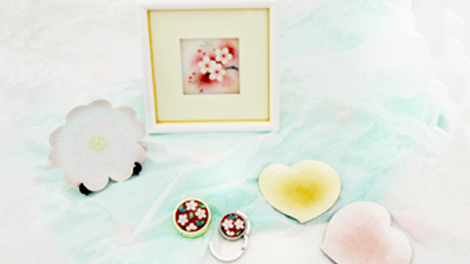
Perhaps because Empress Michiko likes cloisonne, orders are also filled for the Imperial household.
- Takashima
- How do you make cloisonne ware?
- Ando
- Today I’m going to brief you on the entire process until completion. From its appearance, many people think it is porcelain, but it is actually made from metal. Almost all is made from copper plate.
- Takashima
- Really? I had no idea. Doesn’t it break?
- Ando
- It actually doesn’t. Sometimes it gets small cracks in it, but it does not break.
- Takashima
- How does copper plate get such vivid colors?
- Ando
- We use an enamel-like material. Cloisonne is precious metal decorated with glass. For the primary example, you first add a white glaze to get rid of the redness of the copper. Then you hand paint flowers and other designs.
- Takashima
- Interesting… On this piece, the outline of the design is raised up.
- Ando
- This is because the lines are laid on by placing ribbons of it along a sketch of the design so they stand up vertically.
- Takashima
- That is incredible. You would have to be extremely dexterous!
- Ando
- Yes. You have to lay the lines with tweezers and scissors. They are tacked in place with a paste made by dissolving powdered orchid bulb in hot water.
- Takashima
- Ah, my husband would be good at that. He is really dexterous (laughs). What is the next step?
- Ando
- Colored glass that has been pulverized into a powder is used as the paint to fill the compartments between the lines. Red is put in the red compartments, pink in the pink ones, and so on until they are all filled with color, and then the piece is fired.
- Takashima
- And these steps are all repeated.
- Ando
- Yes, exactly. When done only once, the color sinks down after firing, so colors have to be lain the same way 2 or 3 times until they reach the height of the lines. After firing, the surface becomes slightly uneven, so it has to be polished. First, it is smoothed down with a sandstone, then polished with oxidized tin or carbon to bring back the shine.
- Takashima
- What a complicated art. It takes patience, like the people who draw pictures on grains of rice. I had no idea cloisonne ware required such complex techniques.
- Ando
- We have not advertised enough, and many people do not know about it.
- Takashima
- You also receive orders from the Imperial household?
- Ando
- Yes. In 1900, we were made purveyors to the Imperial Household Agency, but this system no longer exists, so now we simply fill orders we have received from the supplies department of the Agency.
- Takashima
- Amazing. What types of items do you deliver there?
- Ando
- The members of the Imperial family each have a special emblem that is a symbol used to represent their own things. For example, we have made a jewel box decorated with a white birch of Japan that is the emblem of Empress Michiko and we have made sets of cherry blossom decorated serving plates. These are given as gifts during official business with the Imperial household within and outside Japan.
- Takashima
- How much do the most expensive cloisonne ware pieces cost?
- Ando
- We have pieces from the Meiji era in Nagoya made with very advanced techniques that are used as models for our craftspersons. They are not priced, but considering the time and effort that would have been required at the time, they would be in the range of tens of millions of yen.
- Takashima
- Really? That much!
- Ando
- Yes. At the Ginza shop, we recently made a cloisonne Globe that is almost 9 million yen, so if the piece is really complex, the price can run quite high. Cloisonne is different from gems like diamonds, gold or silver in that the price is not intrinsic — the time and effort that went into making it is what is paid for, so when pieces are really expensive, it shows just how much time went into it by a very accomplished artisan.
- Takashima
- You are paying for the skills and the time. It is a wonderful craft that Japan can be proud of.
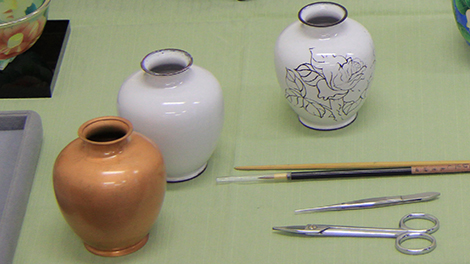
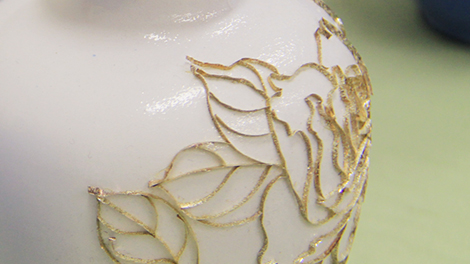
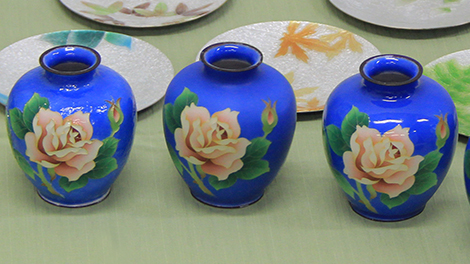
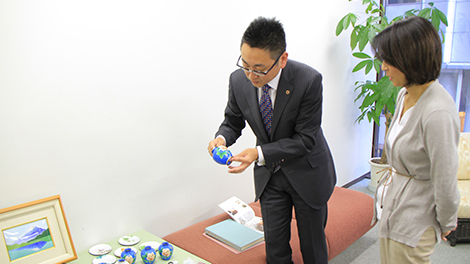
1 2
All List
- GINZA CONNECTIVE VOL.0 Ryo Sayegusa×Chisako Takashima
- GINZA CONNECTIVE VOL.1 Toshiyuki Kosaka×Chisako Takashima
- GINZA CONNECTIVE VOL.2 Yasuharu Mizuhara×Chisako Takashima
- GINZA CONNECTIVE VOL.3 Hitoshi Ishihara×Chisako Takashima
- GINZA CONNECTIVE VOL.4 Shinji Hara×Chisako Takashima
- GINZA CONNECTIVE VOL.5 Choichiro Motoyama×Chisako Takashima
- GINZA CONNECTIVE VOL.6 Noriko Okazoe×Chisako Takashima
- GINZA CONNECTIVE VOL.7 Choichiro Motoyama×Chisako Takashima
- GINZA CONNECTIVE VOL.8 Sayuri Yamaguchi×Chisako Takashima
- GINZA CONNECTIVE VOL.9 Yoshiki Tani×Chisako Takashima
- GINZA CONNECTIVE VOL.10 Yoshifumi Itoh×Chisako Takashima
- GINZA CONNECTIVE VOL.11 Kunihiko Miwa×Chisako Takashima
- GINZA CONNECTIVE VOL.12 Shin Watanabe×Chisako Takashima
- GINZA CONNECTIVE VOL.13 Akihiko Tsuda×Chisako Takashima
- GINZA CONNECTIVE VOL.14 Rie Horikawa×Chisako Takashima
- GINZA CONNECTIVE VOL.15 Jun Takahashi×Chisako Takashima
- GINZA CONNECTIVE VOL.16 Yusuke Harada×Chisako Takashima
- GINZA CONNECTIVE VOL.17 Lintaro Mizuhara×Chisako Takashima
- GINZA CONNECTIVE VOL.18 Keisuke Anzai×Chisako Takashima
- GINZA CONNECTIVE VOL.19 Hozu Yamamoto×Chisako Takashima
- GINZA CONNECTIVE VOL.20 Koji Shibata×Chisako Takashima
- GINZA CONNECTIVE VOL.21 Kayo Hosono×Chisako Takashima
- GINZA CONNECTIVE VOL.22 Mitsuru Saito×Chisako Takashima
- GINZA CONNECTIVE VOL.23 Akihisa Kawaguchi×Chisako Takashima
- GINZA CONNECTIVE VOL.24 Mamoru Sugiyama×Chisako Takashima
- GINZA CONNECTIVE VOL.25 Michiaki Kumagai×Chisako Takashima
- GINZA CONNECTIVE VOL.26 Shinichi Tanizawa×Chisako Takashima
- GINZA CONNECTIVE VOL.27 Koichi Suzuki×Chisako Takashima
- GINZA CONNECTIVE VOL.28 Munehito Matsuzaki×Chisako Takashima
- GINZA CONNECTIVE VOL.29 Hiroshi Hara × Chisako Takashima
- GINZA CONNECTIVE VOL.30 Shigeyuki Ando×Chisako Takashima
- GINZA CONNECTIVE VOL.31 Yukichi Ishikura × Chisako Takashima
- GINZA CONNECTIVE VOL.32 Seiko Yamada × Chisako Takashima
- GINZA CONNECTIVE VOL.33 Mami Nagai × Chisako Takashima
- GINZA CONNECTIVE VOL.34 Ryuta Takahashi × Chisako Takashima
- GINZA CONNECTIVE VOL.35 Kazumasa Osumi×Chisako Takashima
- GINZA CONNECTIVE VOL.36 Masahiro Kameoka×Chisako Takashima
- GINZA CONNECTIVE VOL.37 Shoichiro Watanabe×Chisako Takashima
- GINZA CONNECTIVE VOL.38 Keiji Niimoto×Chisako Takashima
- GINZA CONNECTIVE VOL.39 Chieko Nakamura ×Chisako Takashima
- GINZA CONNECTIVE VOL.40 Atsushi Yamane×Chisako Takashima
- GINZA CONNECTIVE VOL.41 Masaya Shibuya×Chisako Takashima
- GINZA CONNECTIVE VOL.42 Makoto Suzuki×Chisako Takashima
- GINZA CONNECTIVE VOL.43 Masaya Konaka×Chisako Takashima
- GINZA CONNECTIVE VOL.44 Masakazu Tanaka×Chisako Takashima
- GINZA CONNECTIVE VOL.45 Koko Kameoka × Chisako Takashima
- GINZA CONNECTIVE VOL.46 Jin Hirayama×Chisako Takashima
- GINZA CONNECTIVE VOL.47 Takashi Hoshihara×Chisako Takashima
- GINZA CONNECTIVE VOL.48 Mikiko Kimura × Chisako Takashima
- GINZA CONNECTIVE VOL.49 Keisuke Okamoto×Chisako Takashima
- GINZA CONNECTIVE VOL.50 Akira Ito × Chisako Takashima
- GINZA CONNECTIVE VOL.51 Tatsuhiko Adachi × Chisako Takashima
- GINZA CONNECTIVE VOL.52 Masahiko Yamano×Chisako Takashima
- GINZA CONNECTIVE VOL.53 Kiyoshi Kanazashi×Chisako Takashima
- GINZA CONNECTIVE VOL.54 Noriyuki Tsuji×Chisako Takashima
- GINZA CONNECTIVE VOL.55 Shoichi Kobayashi×Chisako Takashima
- GINZA CONNECTIVE VOL.56 Isao Nanjo×Chisako Takashima
- GINZA CONNECTIVE VOL.57 Shinobu Mitsuoka×Chisako Takashima
- GINZA CONNECTIVE VOL.58 Motoyoshi Yasuda×Chisako Takashima
- GINZA CONNECTIVE VOL.59 Toru Fujiki×Chisako Takashima
- GINZA CONNECTIVE VOL.60 Yuji Ida×Chisako Takashima
- GINZA CONNECTIVE VOL.61 Hitoshi Miki×Chisako Takashima
- GINZA CONNECTIVE VOL.62 Takehiko Furuya× Chisako Takashima
- GINZA CONNECTIVE VOL.63 Naoki Yoshizawa×Yusuke Yoshizawa×Chisako Takashima
- GINZA CONNECTIVE VOL.64 Kazuhito Kawase × Chisako Takashima
- GINZA CONNECTIVE VOL.65 Toshiji Yuki× Chisako Takashima
- GINZA CONNECTIVE VOL.66 Hikoyuki Yamaguchi×Chisako Takashima
- GINZA CONNECTIVE VOL.67 Daisuke Nagano×Chisako Takashima
- GINZA CONNECTIVE VOL.68 Shuichi Motohashi× Chisako Takashima
- GINZA CONNECTIVE VOL.69 Shinpei Tonaka×Chisako Takashima
- GINZA CONNECTIVE VOL.70 Shinya Kanematsu × Sachiko Takashima
- GINZA CONNECTIVE VOL.71 Masataka Yano×Chisako Takashima
- GINZA CONNECTIVE VOL.72 Mitsuhiro Kurokawa× Chisako Takashima
- GINZA CONNECTIVE VOL.73 Ryo Saegusa×Chisako Takashima








